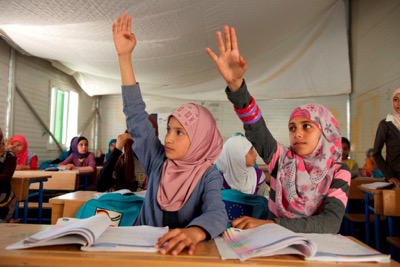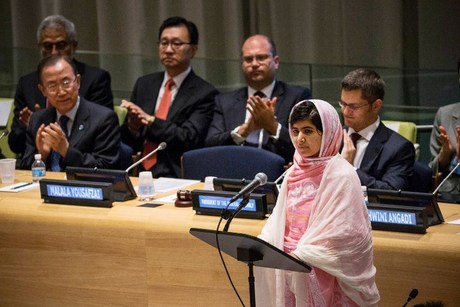I was introduced to the world of Model UN by a tall, white boy in a red power tie. Pakistan was the first speaker in the DISEC room of my freshman year’s first conference, and as a nervous, new delegate assigned the country of Senegal and a seat in the back corner of an over-crowded committee room, a presence that reflected the societal image of “leadership” seemed like the greatest source of security I could have asked for. I, along with most of the other confused novices, signed onto his working paper and joined his United bloc with aplomb. We were drawn not to cult of personality nor ingenuity of ideas, but the mere fact that following Pakistan seemed akin to what we were supposed to be doing: being a part of a majority bloc led by a commanding figure and his lieutenants, signing and voting for a draft resolution our countries could reasonably agree with, and acting like we learned something once it was all over. Though the United Paper (or Working Paper 1.1 for traditionalists) was passed by the rowdy DISEC delegates and I could leave saying I was a member, though not a very important one, of the largest bloc in the room, the only thing I felt I’d learned was how to follow someone else’s leadership — and in my case, it was the ostentatious, prototypical leadership of a tall, white man in a red power tie. But I’ve always wondered why we, the unsure delegates, gravitated so willingly, so automatically to Pakistan. And as a grown as both a delegate and a person, my question has since expanded: Why is the most obvious image of a leader, in Model UN and in life, a white man in a power tie?

I have spent my entire MUN career attempting to subvert this trope. I have never believed that MUN should be an activity through which stereotypes of political leaders are actively enforced; rather, I believe that Model UN is a platform through which the next generation of political leaders can actively fight against society’s norms of who can be a leader and what constitutes leadership. Any delegate, no matter their background, training, or experience, can take the floor and deliver a speech with panache, can write an excellent and thorough working paper, can earn the respect and admiration of their peers. Yet Model UN seems to have an issue with recognizing leadership of delegates whose styles fall outside the norms of their perceived identity, thereby negating many of the positive effects this platform could have.
One of the most odious examples of this trend is the role of women in Model UN. Sexism is never overt in MUN. In fact, many MUN purists and believers shirk the idea that sexism could ever hold a prominent place in the activity. And from an idealist’s perspective, how could it? Model United Nations is an activity of would-be diplomats that emphasizes teamwork and getting along, effective communication, idea sharing, and the importance of all ideas and opinions. Nobody will ever admit to not liking, respecting, or awarding a delegate because she is female. It will never be this obvious. Instead, delegates in committee will claim that a delegate was too aggressive, will claim that a delegate was not inclusive enough, will claim that she was a “gavel hunter” or a “power delegate”. Instead, chairs will ironically decide that this same delegate was too nice, was too diplomatic, that she let herself get talked over by the more aggressive men in committee, that she didn’t present her ideas actively enough or control her other bloc members willingly enough. Or they will fall into believing those same things as the delegates of the room — that one of the committee’s strongest leaders was somehow too strong, even as the men around her continue to overbear and dominate with the same style others degrade her for using.
I am not a stranger to these occurrences. At the conclusion of a one-day training simulation near the beginning of my junior year of high school — a General Assembly plenary committee discussing Non-State Terrorism during which I represented the country of Yemen — I was approached by my advisor and mentor, a person I had learned to admire for his honest, assuring demeanor and his knowledge of the Model UN world. I was excited to hear his feedback. I believed I had done and done well all of the aspects of MUN he had taught me. I had made effective speeches; I had lead a bloc; I had been the first sponsor on a working paper; I had passed my draft resolution. Up to that point, that simulation and my performance in it had been an affirmation of my ability as a delegate, that I wasn’t misguided in believing that Model UN might be something I could enjoy and do well in. The words this advisor told me, however, were different than what I was expecting: “You’re a great delegate, but you might want to tone down your intensity a bit just because you’re a girl and people are going to think you’re too pushy if you’re aggressive.” I knew he was right. But that didn’t mean I wanted to listen to him. It’s not my style to hold back or be laid-back. More than anything, though, it’s not my style to accept the conventions of society just because they are conventions, just because it may be conventional to accept them.
From that point on, I decided that I wanted to prove aggressive females can be successful in Model UN. I decided that I would not conform to what a female delegate is “supposed” to be; instead, I would work to redefine and expand what a female delegate could be. I am proud to say that in all my MUN experience, in all the committees I have ever participated in, at all the conferences I have ever attended, from General Assemblies to ECOSOCs to Regional Bodies to Specialized Agencies to Crisis Committees, from the Midwest to the East Coast to India, I have tried my hardest not to compromise my personality to fit conventional gender roles of what female leadership looks like. I have won awards at major conferences, I served as Secretary-General of three conferences, I have been entrusted to teach the next generation of Model UN delegates as a proud, aggressive female delegate. Could I have won a couple of more awards if I had “toned things down?” Likely. Do I care? Not particularly. Because female leadership can be anything, can look like anything, can encompass anything. It is time we begin to embrace this.

We, as a Model UN community, need to stop believing that there is only one type of effective female delegate, that there is only one type of effective female leadership. We cannot effectively combat a stigma if we continue to reinforce it. If MUN is meant to be representative of the world’s future leaders, we need to emphasize that women shouldn’t need to fall into patriarchal gender roles in order to be accepted by a male-dominated industry in a male-dominated society (the industry, in this context, being politics and political leadership). This is especially because if women keep changing themselves to fit these pre-determined gender roles, society will continue to question why they didn’t push themselves harder to break the mold, even when they only conformed in the first place because they are continuously told conforming is the only way through which they can be successful.
I’m not saying it is the responsibility of the Model UN world to single-handedly dispel the dominant gender roles that exist within its bounds, to solve this dramatic and ever-present issue totally and completely. It is probably unrealistic to believe that an issue as difficult and complex as this one will ever be totally solved. What I am saying is that we at least need to recognize that this issue is a problem, that we at least need to try, as best we can, to solve this problem as a MUN community.
I hope that one day, young women will be able to walk into their first committee session at the first conference and trust that the tall, boy in the red power tie isn’t the only leader in the room.

